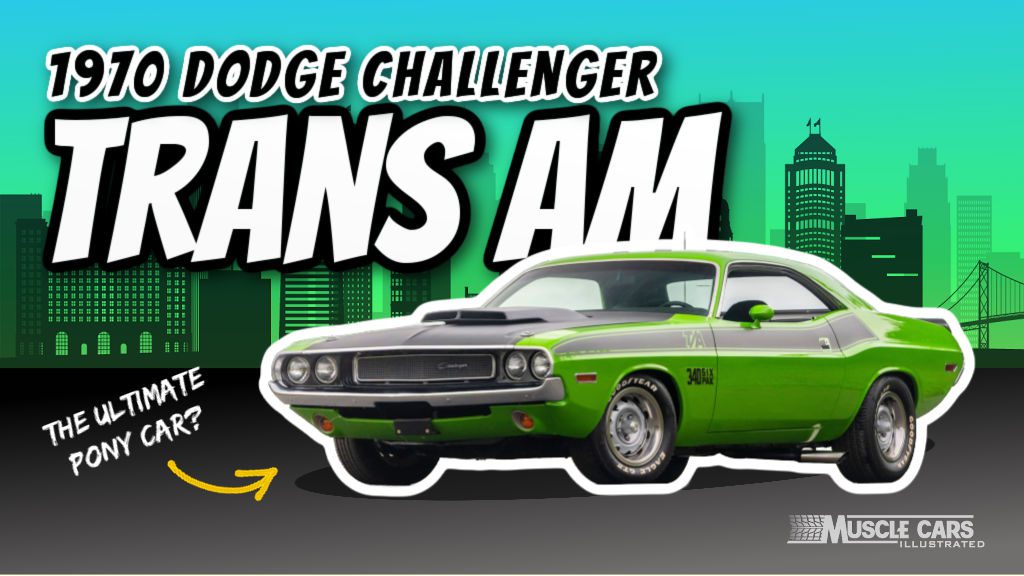
Ever caught a glimpse of a 1970 Dodge Challenger T/A?
Imagine it’s 1970: the air is thick with the spirit of revolution, the Beatles’ last album, “Let It Be,” is spinning on turntables, and the roads are a battleground for muscle car supremacy.
Into this charged atmosphere drives the Dodge Challenger T/A, a pony car ready to challenge the status quo and set the streets ablaze with its raw power and undeniable swagger.
With a moniker like T/A, short for Trans Am, this Challenger wasn’t just another contender in the muscle car arena but a declaration of Dodge’s racing ambitions and engineering acumen.
Buckle up because we’re about to peel back the layers of this iconic piece of American muscle. We’ll explore what catapulted the 1970 Challenger T/A into the annals of automotive legend, from its Mopar small block engine performance to its striking one-of-a-kind design.
This isn’t just a story about a car; it’s a journey back to when horsepower ruled and the open road was a canvas for the bold. The 1970 Dodge Challenger T/A was more than a machine—it symbolized freedom and open rebellion between stoplights.
Prepare to discover the soul of the 1970 Challenger T/A, a true masterpiece of American engineering that continues to capture the hearts and imaginations of car enthusiasts.
Let’s dive into the 1970 Dodge Challenger T/A tale, shall we?
Table of Contents
What is a Dodge Challenger T/A?
The 1970 Dodge Challenger T/A, a one-year-only model, was introduced as part of Dodge’s entry into the SCCA’s Trans American Sedan Championship alongside the Plymouth AAR ‘Cuda.
The Challenger T/A, introduced in 1970 with the new E-body style, featured a 340 cubic inch V8 engine equipped with a Six Pack (three two-barrel carburetors), producing 290 horsepower.
Notable features included a functional fiberglass hood with an air scoop, side-exit exhausts, a unique suspension with staggered tire sizes, and distinctive styling with thick side stripes and “T/A” decals.
Here’s everything included in the $886.70 T/A Challenger option package:
| Feature | Description |
|---|---|
| T/A Package Cost | $865.70 |
| Total Sticker Price | Roughly $4,100 |
| Engine | 340 CID with Six Pack |
| Brakes | Power disc brakes |
| Suspension | H.D. Shocks and suspension |
| Hood | Fiberglass hood and fresh air package |
| Rear Spoiler | Ducktail |
| Mirror | Left remote control mirror |
| Gas Cap | Locking flip-top gas cap |
| Tape Stripe | T/A tape stripe |
| Spare Tire | Collapsible spare tire |
| Tires | E60x15 Front and G60x15 rear with raised white letters |
| Wheels | 15×7 steel wheels with hub center and chrome trim rings |
Dodge produced 2,399 units to comply with homologation rules, pitting the Challenger T/A against series favorites like the Ford Boss 302 Mustang, Pontiac Firebird Trans Am, AMC Javelin Mark Donohue, Plymouth AAR ‘Cuda, and Chevrolet Camaro Z/28.
Sam Posey drove the Challenger T/A for Dodge’s team. Although the Challenger T/A did not win a championship in 1970, its participation greatly enhanced its racing legacy and street credibility.
Highlights
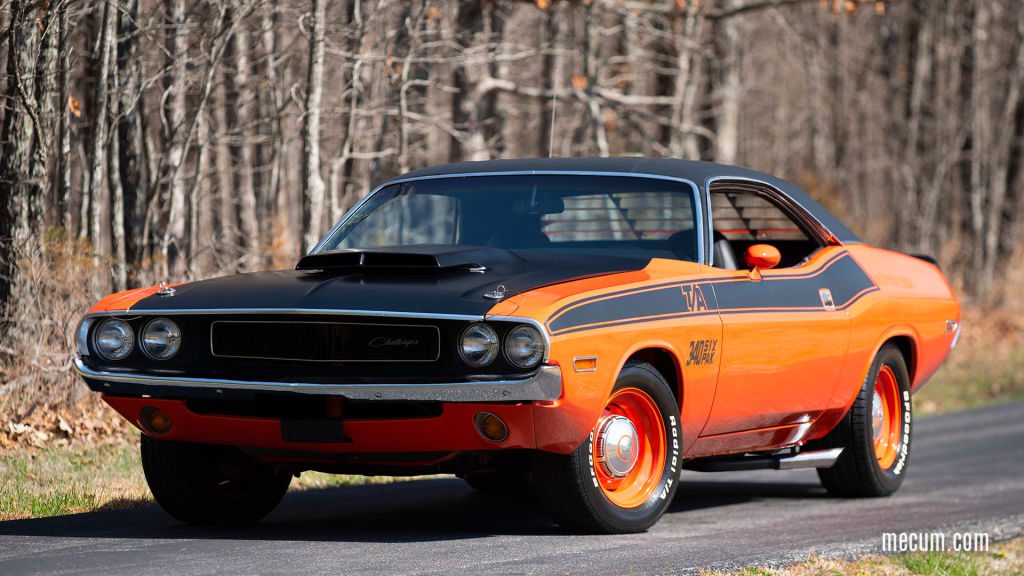
The 1970 Dodge Challenger T/A was engineered for SCCA’s Trans Am racing. Its rarity, with just over 2,000 units produced and distinctive features like the 340 Six Pak engine, 8 3/4 differential, choice of transmissions, and performance-focused design, highlights its unique place in pony car history. This model encapsulates the spirit of the muscle car era with its blend of speed, style, and racing heritage.
| Highlight | Detail |
|---|---|
| Production | 2,399 units produced in 1970 |
| Name Origin | “T/A” stands for Trans Am, named after the SCCA racing series |
| Engine | 340 cubic inch V8 with a Six Pack (three two-barrel carburetors), rated at 290 HP |
| Transmission | Standard pistol-grip Hurst-shifted four-speed A-833 close ratio manual, optional 3-speed Heavy Duty TorqueFlite automatic |
| Differential | Sure Grip-equipped 8¾-inch differential |
| Performance | Capable of running a high 13-second quarter-mile |
| Development | Developed to qualify for the SCCA Trans Am racing series by producing a street version of the race car |
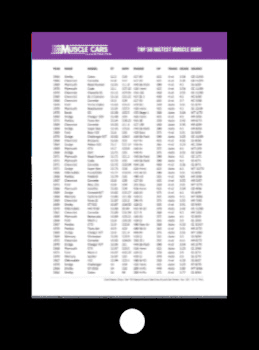
Get The Top 50 Fastest Muscle Cars chart. Includes year, model, engine, 1/4 mile times, and more—absolutely free!
Styling
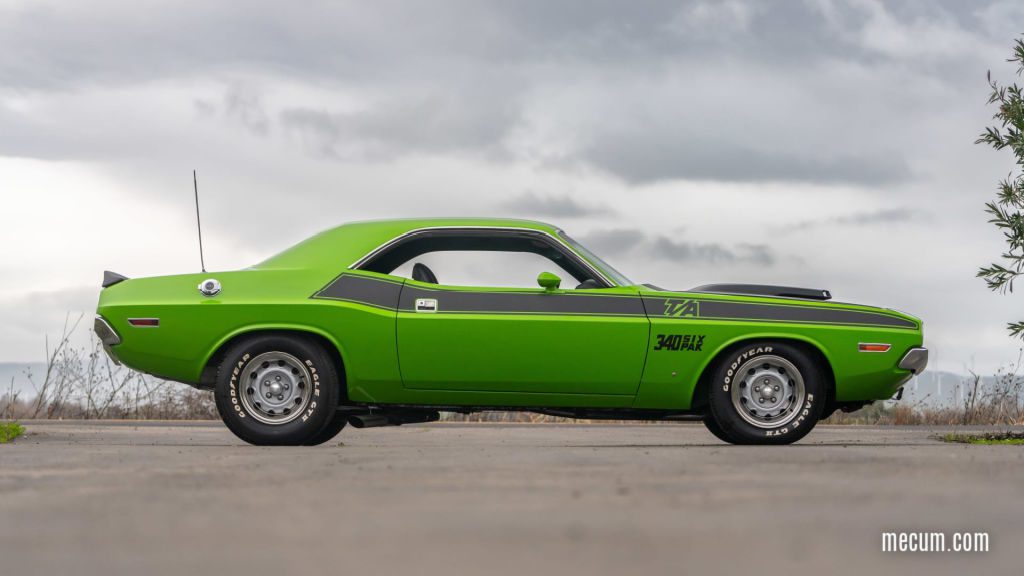
The Challenger T/A exuded a distinct styling that set it apart from its contemporaries, encapsulating the essence of American muscle cars with an aggressive and sporty aesthetic. Features include a striking matte-black fiberglass hood and hood pins, with a functional scoop to feed the 340 Six Pak engine beneath, complemented by side-exit exhausts that added to its race-ready appearance. Decorated with bold graphics, including thick side stripes that bore the T/A moniker and a black ducktail rear spoiler that enhanced its aerodynamic profile. The Challenger T/A also boasted a unique stance, thanks to its staggered wheel setup with larger tires at the rear, further emphasizing its performance-oriented design.
| Styling Feature | Description |
|---|---|
| Hood | Functional fiberglass with a large, pinned-down, Organosol matte-black “Scat Scoop” air intake |
| Spoilers | Fiberglass ducktail rear spoiler and optional front spoiler for aerodynamics and style |
| Exhaust | Side-exit “megaphone” exhaust tips for a unique look and sound |
| Stripes and Graphics | Thick dual side stripes with “T/A” and “340 SIX PACK” callouts |
| Tires | Different size front (E60x15) and rear (G60x15) Goodyear Polyglas GT tires for a raked stance |
| Wheels | Body-color steel wheels with bright metal trim rings and “dog-dish” center caps; optional silver Rallye wheels |
| Exterior Mirrors | Body-color driver’s exterior mirror, with matching passenger side optional |
| Fuel Filler Cap | Snap-open fuel filler cap |
Challenger T/A Paint Colors
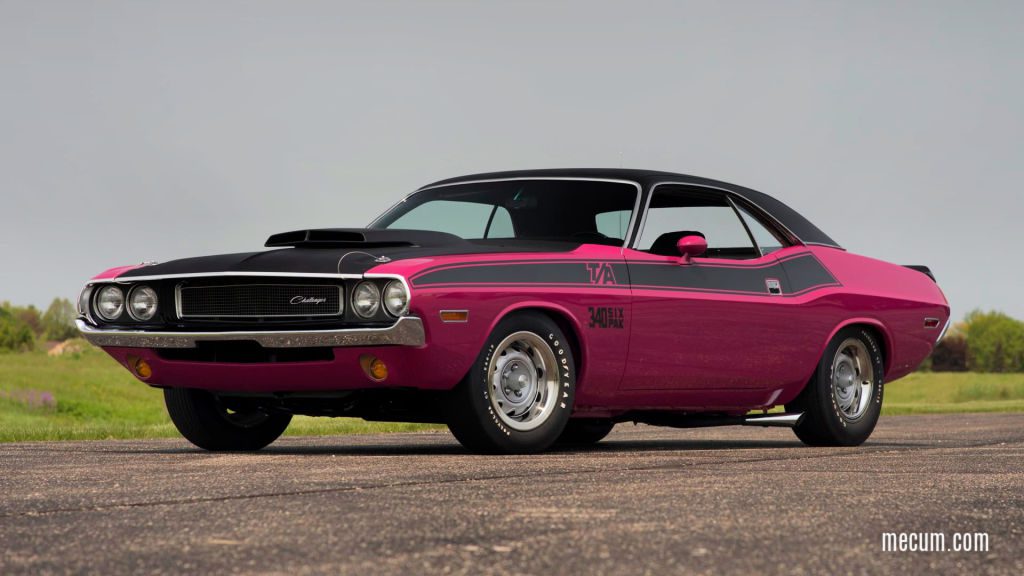
The 1970 Dodge Challenger T/A was offered in a palette of 20 distinct colors designed to cater to a broad spectrum of tastes and preferences. Among these, seven were bold and vivid shades that could be obtained for an additional cost of $14.05. While Plymouth branded their vibrant and bold color options as “High Impact Colors,” Dodge chose to describe their equally striking and vivid palette with “High Performance Colors.” The chart below details each color’s code and name and whether it was a High Performance Color.
| Color Code | Paint Color Name | High Impact Color |
|---|---|---|
| EK2 | Go-Mango | ✅ |
| EV2 | Hemi Orange | ✅ |
| FC7 | Plum Crazy | ✅ |
| FJ5 | Sub Lime | ✅ |
| FJ6 | Green Go | ✅ |
| FM3 | Panther Pink | ✅ |
| FY1 | Top Banana | ✅ |
| BL1 | Beige | ❌ |
| DY3 | Cream | ❌ |
| EB3 | Light Blue Metallic | ❌ |
| EB5 | Bright Blue Metallic | ❌ |
| EB7 | Medium Blue Metallic | ❌ |
| EF8 | Dark Green Metallic | ❌ |
| EW1 | Eggshell White | ❌ |
| FE5 | Bright Red | ❌ |
| FF4 | Light Green Metallic | ❌ |
| FK5 | Dark Burnt Orange Metallic | ❌ |
| FT6 | Dark Tan Metallic | ❌ |
| FY4 | Light Gold Metallic | ❌ |
| TX9 | Black | ❌ |
Engine
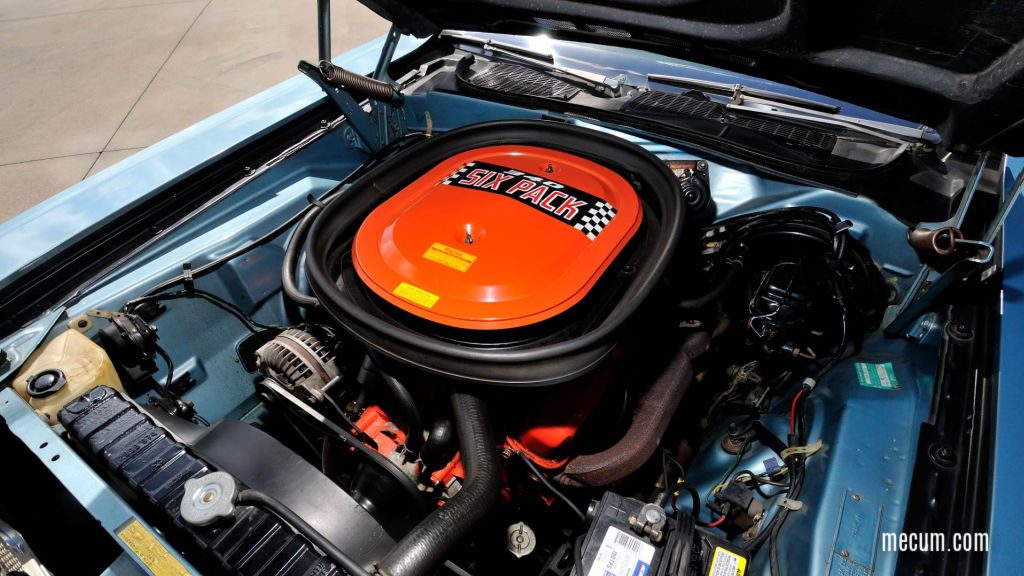
The 1970 Dodge Challenger T/A and Plymouth AAR ‘Cuda were powered by a special 340 cubic inch V8 engine, notable for its 4-bolt main construction, a bore and stroke of 4.04 x 3.31 inches, and topped with a Six Pack—three two-barrel Holley 2300 carburetors with vacuum-operated secondaries on an aluminum Edelbrock intake manifold. This setup produced 290 horsepower at 5,000 rpm and 345 lb-ft of torque at 3,400 rpm, with a compression ratio of 10.5:1. The combination of these specifications made the engine unique to these models, offering a blend of high performance and rarity that has since become legendary among muscle car enthusiasts. Air conditioning was not available as an option.
| Specification | Detail |
|---|---|
| Engine Type | V8 |
| Displacement | 340 cubic inches (4-bolt main) |
| Bore & Stroke | 4.04 x 3.31-inch |
| Carbs | Six Pack (three two-barrel Holley 2300 carbs with vacuum-operated secondaries) |
| Intake | Aluminum Edelbrock intake |
| Horsepower | 290 hp @ 5,000 rpm |
| Torque | 345 lb-ft @ 3,400 rpm |
| Compression Ratio | 10.5:1 |
Production
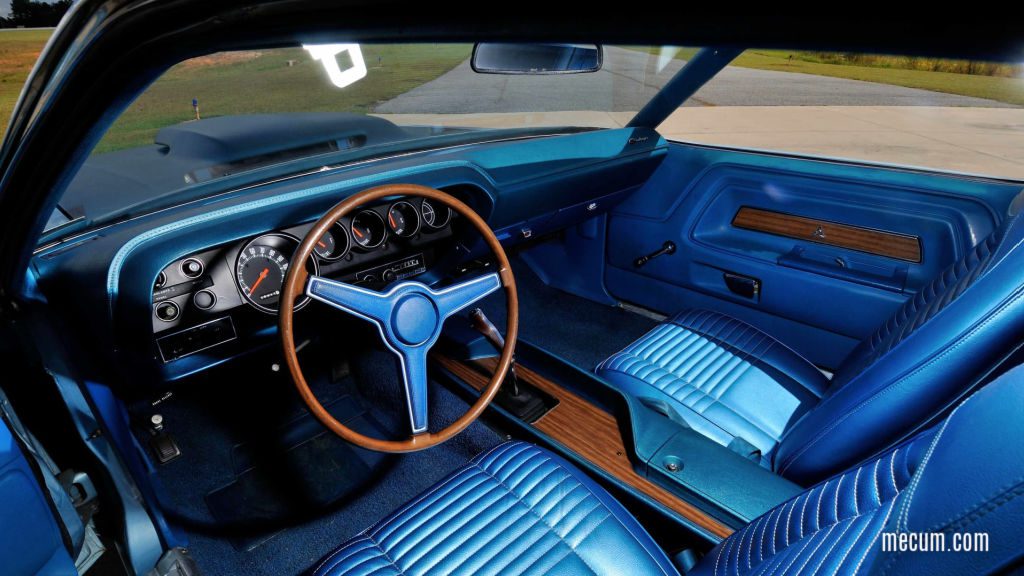
The 1970 Dodge Challenger T/A had a limited production run, with 2,399 units manufactured. Of these, 1,410 were equipped with an automatic transmission, while the remaining 989 featured a manual transmission. This production distribution highlights the Challenger T/A’s appeal to a broad spectrum of muscle car enthusiasts, offering options for those who prefer the ease of an automatic and those who seek the engagement of a manual gearbox.
| Transmission Type | Production Numbers |
|---|---|
| Automatic | 1,410 |
| Manual | 989 |
| Total | 2,399 |
Performance
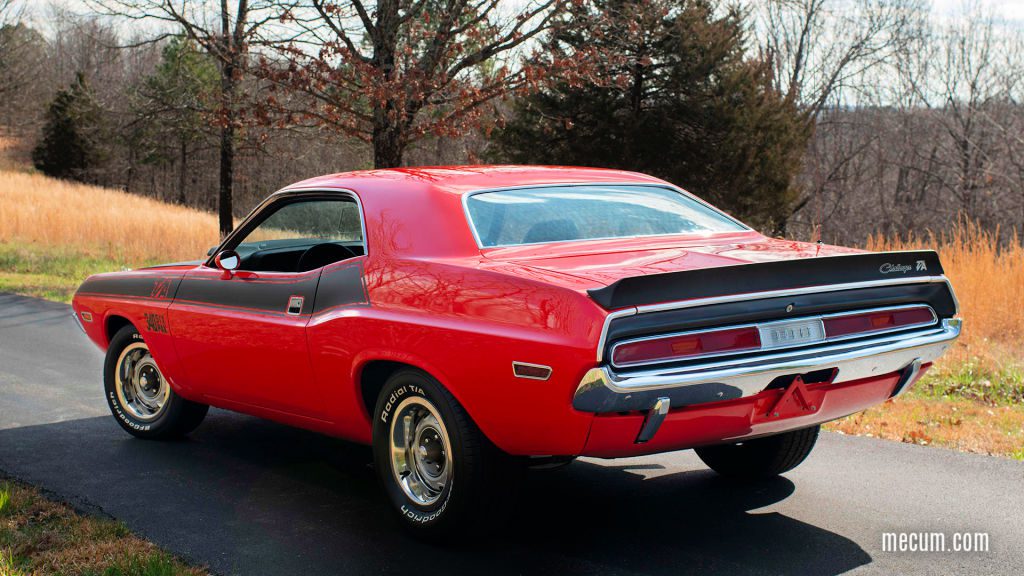
Featured in the August 1970 edition of Hi-Performance Cars magazine, the Dodge Challenger T/A showcased remarkable performance, completing the quarter-mile in 13.99 seconds at 100 mph. In contrast, the Plymouth ‘Cuda AAR completed the same distance in 14.40 seconds at 98.4 mph, as reported by the June 1970 issue of Sports Car Graphic.
| Performance Metric | Value |
|---|---|
| Quarter-Mile Time | 13.99 seconds |
| Quarter-Mile Speed | 100 miles/hour |
Window Sticker
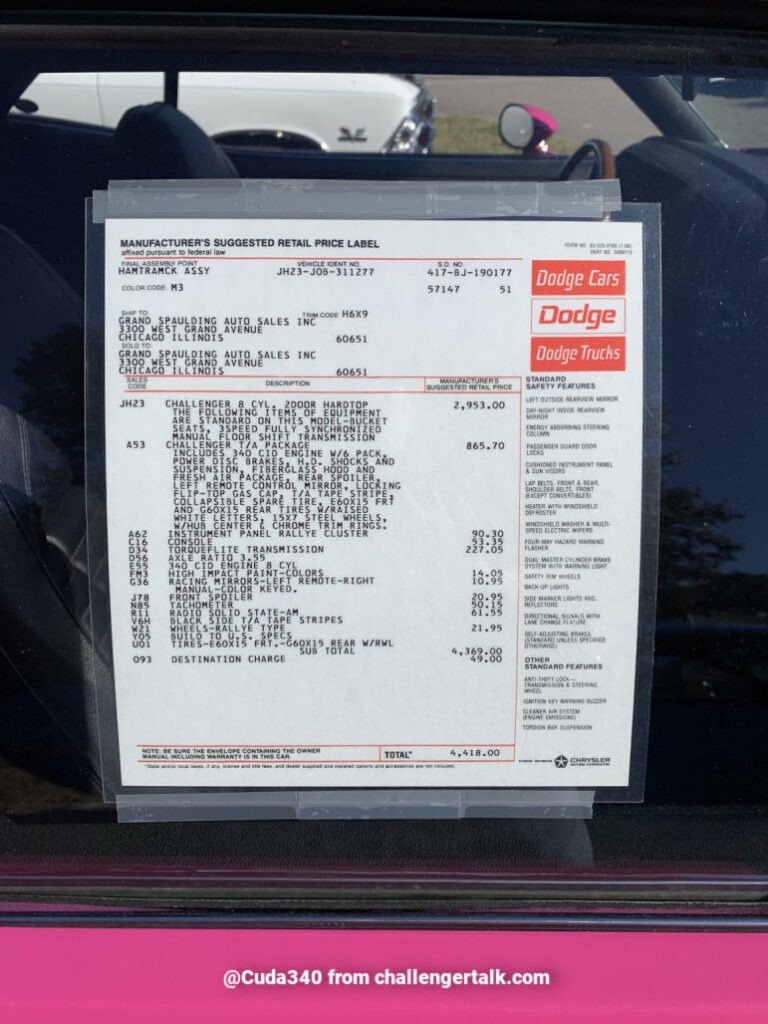
Conclusion
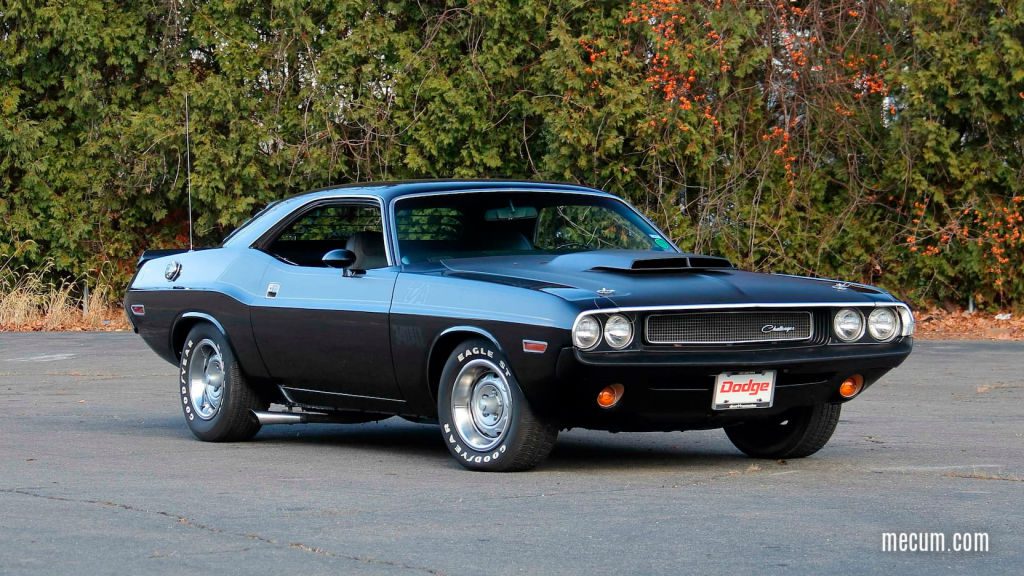
As the dust settles on the roaring tracks of yesteryears, the 1970 Dodge Challenger T/A stands tall, a legacy of Dodge’s racing spirit and pony car ambitions. In the heart of the high-stakes SCAA racing scene, the Challenger T/A, alongside its fierce sibling, the Plymouth ‘Cuda AAR, etched its legacy into the annals of automotive lore. Every twist of the wheel and stomp of the gas pedal embodied the raw excitement and boundless innovation that defined the golden age of pony car racing.
Challenger T/As in the Brothers Collection
In the intricate tapestry of Mopar history, one name stands out as an authority: Dave Wise. Renowned as a Mopar judge and authenticator, Wise has devoted decades to unraveling the mysteries of Chrysler’s iconic muscle cars. Watch a video of Dave explaining the history of the Challenger T/A and AAR ‘Cuda, filmed at the Brothers Collection in Salem, Oregon.
1970 Dodge Challenger Related Questions
The 1970 Dodge Challenger T/A was equipped with a 340 cubic inch V8 engine featuring a trio of two-barrel carburetors, known as the 340 Six Pack, rated at 290 horsepower at 5,000 rpm and 345 lb-ft of torque at 3,400 rpm. The block featured a 4.04 x 3.31-inch bore and stroke and a 10.5:1 compression ratio.
A total of 2,399 Dodge Challenger T/As were produced in 1970.
The T/A package on a 1970 Dodge Challenger included a 340 cubic inch V8 with a Six Pack (three two-barrel carburetors), a functional fiberglass hood with a large air scoop, a ducktail rear spoiler, side-exit “megaphone” exhaust tips, a special Rallye suspension with different-size front and rear tires for a raked stance, and distinctive exterior graphics, including thick side stripes and T/A decals.
“T/A” on a Challenger stands for “Trans Am,” referring to the model’s homologation for participation in the Sports Car Club of America’s Trans American Sedan Championship.
The Challenger T/A was capable of 13.99-second quarter-mile traveling at 100 miles per hour.
The Challenger T/A and Plymouth AAR ‘Cuda were built for SCCA Trans-Am racing homologation. Both cars share the same drivetrain and deliver similar performance but differ in design and brand identity.
SCCA racing was a pivotal period for American motorsports, specifically referring to the Sports Car Club of America’s activities starting in 1966. Racing in the SCCA Trans Am series was highly competitive, with factory-backed teams and prominent drivers participating in grueling races that tested the cars’ durability, speed, and handling. The series emphasized power and the importance of braking, handling, and strategy, making it an exhaustive test of the driver’s skills.
Take Our Poll!
"*" indicates required fields
Sources: Hemmings, Hagerty, Dodge Garage, & Wikipedia

Ryan Wheaton
Ryan has owned muscle cars since 1986 and currently owns a 1972 Dodge Charger Rallye. He combines passion and experience to create engaging content for fellow muscle car enthusiasts. In 2018, he founded Muscle Cars Illustrated, authoring hundreds of articles on tips, history, and trends in the muscle car industry. He attends national car shows, auctions, and museums to stay current with the latest developments in the muscle car industry.
